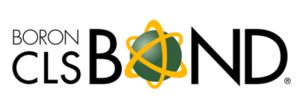The Development and Principle of
Boron-CLS-BOND® Technology
New and patented Boron-CLS-Bond® is a biodegradable lubrication technology designed for the latest mechanical advances in precision engineering. The technology platform was originally discovered and patented by the U.S. Department of Energy’s Argonne National Laboratory of Argonne, Illinois, operated by the University of Chicago. In 1991, it was awarded the prestigious R&D 100 award for what has become Boron-CLS-Bond® technology.
Boron-CLS-Bond® technology is based on using molecular boric acid to form a solid boundary-layer component, which is synergistic with the hydraulic (fluid) lubricant delivery and/or dispersal vehicle. In the presence of oxygen and moisture, boric acid reacts with metal via covalent bonds to form approximately a 20-nanometer surface of metallic boric oxide that is 85% hardness of diamond (Rockwell 85).
In the presence of oxygen and free boric acid, the metallic boric oxide surface spontaneously produces more boric acid, the molecules of which form a macromolecular bond to form a crystalline lattice of platelets. The boundary layer of platelets is approximately 100 to 400 nanometers thick. These platelets align themselves parallel to the metal surface and conform to the direction of movement – like a loosely dispersed deck of playing cards.

Each Boron-CLS-Bond® platelet has strong macromolecular bond. Only weak Van der Waals forces attract the platelets to each other, allowing virtually frictionless platelet-to-platelet interaction. These double boron boundaries translate to an extremely low-friction coefficient (under 0.01 percent) between the platelets separating metal surfaces and with negligible wear on the metal surfaces they separate.
Minute amounts of residual boric acid in the presence of moisture and oxygen cause any sheared platelets to be rapidly replaced in a self-renewing cycle of boric acid – metallic boric oxide – crystalline boric acid platelet regeneration and bonding, thus a self-replenishing lubricant.
Product and application specific solutions have been tested extensively in independent laboratories, universities, research centers and in the field worldwide. The benefits of Boron-CLS-Bond® products have been documented in test after test.
Dramatically Reduces Friction and Wear
Once established on the metal surfaces, Boron-CLS-Bond® outperforms all other fluid or fluid-dispersed extreme-pressure or friction-reduction additives. When Boron-CLS-Bond® chemically bonds with the metal, the resultant boundary layer virtually eliminates metal-to-metal contact. The boric acid platelets reduce friction 80-90 percent and wear 90 percent.
Biodegradable
Boron-CLS-Bond® contains no toxic additives. Boron as one of the elements that make up the planet (combines with oxygen and other elements to form boric acid) is 100 percent biodegradable, ubiquitous in nature, and fundamental to life. Boron-CLS-Bond® products go beyond the commonly required government standards and mandates worldwide. The technology can be used to replace all toxic extreme-pressure additives found in lubricants today such as sulfur/ZDDP, chlorinated paraffin’s, molybdenum, graphite, etc
Eliminates Corrosion and Micropitting
Boron-CLS-Bond® is anti-corrosive with the metallic boric oxide coating, sealing out moisture, acids and oxygen, resulting in the elimination of corrosion and micropitting. The boric acid (PH 5.73) acts as a buffer to dilute or neutralize strong acids and bases, delaying lubricant oxidation.
Protects Metal Surfaces from Deposit Formation, Removes Sludge and Varnish, and Prevents Oxidation
With heat, pressure and time, boric acid’s chemical affinity for metal will allow it to displace other metal surface coatings such as sludge, varnish, carbon deposits and metallic oxides (e.g., ferrous or aluminum oxides). Once displaced, these contaminants can be removed by filtration or by draining and replacing the fluid lubricant. The newly cleaned metal surfaces are sealed by metallic boric oxide, and thus metal or contaminant catalyzed hydrocarbon (oil) oxidation is prevented and the useful life of the fluid lubricant is extended at least two times.
Self-Renewing, Long-Life Lubrication Solution
Utilizing minute amounts of residual boric acid in the presence of moisture and oxygen, any sheared platelets are rapidly replaced in a self-renewing cycle of solid lubricant to metal surface regeneration and bonding. This translates into longer relubrication and service intervals because the metallic boric oxide forms a covalent (very strong) bond with the metal. The Boron-CLS-Bond® boundary layer is virtually permanent and retained even in the absence of or loss of the fluid lubricant (oil). The Boron-CLS-Bond® boundary layer is not removed or is only slightly depleted even after as many as 20 fluid drains over as much as 160,000 kilometers or 3,000+ hours of use.
Versatile and Compatible
You can use Boron-CLS-Bond® to enhance any of your existing lubrication solutions or a custom solution can be created for your unique needs. Custom products often allow a single Boron-CLS-Bond® technology to replace several different lubricant products used in a plant or manufacturing process. The Boron-CLSBond® technology is compatible with most commonly known fluids, base oils and greases. It has been and is being used in virtually all lubrication regimes.
Contributes to the Bottom Line
Boron-CLS-Bond® reduces the total cost of operating and maintaining fluid systems. It maintains the quality and extends the longevity of the base lubricants while offering the greatest protection against friction and wear, resulting in:
- Decreased fuel and energy consumption
- Increased productivity
- Increased efficiency and uptime
- Reduced repair and warranty expenses
- Reduced maintenance expenses
“Boron-CLS-Bond®” is a registered trademark of Advanced Lubrication Technology, Inc.






